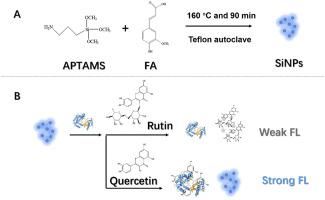当前位置:
X-MOL 学术
›
Anal. Chim. Acta
›
论文详情
Our official English website, www.x-mol.net, welcomes your
feedback! (Note: you will need to create a separate account there.)
Masking quercetin: a simple strategy for selective detection of rutin by combination of bovine serum albumin and fluorescent silicon nanoparticles
Analytica Chimica Acta ( IF 5.7 ) Pub Date : 2020-08-01 , DOI: 10.1016/j.aca.2020.06.002 Lishuang Yu 1 , Shiqi Zhang 1 , Huifeng Xu 2 , Lili Wang 2 , Xi Zhu 3 , Xuzheng Chen 2 , Wen Xu 1 , Wei Xu 1 , Hua Zhang 1 , Yu Lin 1
Analytica Chimica Acta ( IF 5.7 ) Pub Date : 2020-08-01 , DOI: 10.1016/j.aca.2020.06.002 Lishuang Yu 1 , Shiqi Zhang 1 , Huifeng Xu 2 , Lili Wang 2 , Xi Zhu 3 , Xuzheng Chen 2 , Wen Xu 1 , Wei Xu 1 , Hua Zhang 1 , Yu Lin 1
Affiliation

|
As a typical kind of bioactive flavonoid glycoside, rutin and its aglycone quercetin possess similar chemical structures and properties. It still remains a challenge to achieve reliably and accurately detection of rutin in the presence of quercetin. In this work, a simple fluorescent method combining water-dispersed silicon nanoparticles (SiNPs) with bovine serum albumin (BSA) were constructed for the selective detection of rutin in the presence of quercetin and other common compounds in traditional Chinese herbs. SiNPs with high fluorescent quantum yield and good thermostability were prepared by one-pot hydrothermal method using ferulic acid as the reduction reagent for the first time. The fluorescence of SiNPs could be obviously quenched both by rutin and quercetin in phosphate buffer solution. Interestingly, when the solution contained certain concentration of BSA, the fluorescence of the SiNPs can only be remarkably quenched by rutin. The innovative use of BSA to block the interference of quercetin make it possible to selectively detect of rutin by fluorescence spectrometry under the coexistence of quercetin. Under the optimum conditions, the fluorescence displayed a linear decrease response as the rutin concentration increased in the range of 0.33-33.30 μM with a detection limit of 0.04 μM (S/N = 3). The possible quenching mechanism of rutin to SiNPs has also explored and concluded to be mainly caused by inner filter effect. This work provides a novel methodology for the simple, low-cost and selective determination method for rutin.
中文翻译:

掩蔽槲皮素:一种通过结合牛血清白蛋白和荧光硅纳米粒子选择性检测芦丁的简单策略
作为一种典型的生物活性黄酮苷,芦丁及其苷元槲皮素具有相似的化学结构和性质。在槲皮素存在的情况下实现可靠和准确的芦丁检测仍然是一个挑战。在这项工作中,构建了一种将水分散硅纳米粒子 (SiNPs) 与牛血清白蛋白 (BSA) 相结合的简单荧光方法,用于在槲皮素和其他中草药中常见化合物存在的情况下选择性检测芦丁。首次以阿魏酸为还原剂,采用一锅水热法制备了荧光量子产率高、热稳定性好的SiNPs。在磷酸盐缓冲溶液中,芦丁和槲皮素均可明显猝灭SiNPs的荧光。有趣的是,当溶液中含有一定浓度的 BSA 时,SiNPs 的荧光只能被芦丁显着淬灭。创新性地利用BSA阻断槲皮素的干扰,使得在槲皮素共存下荧光光谱法选择性检测芦丁成为可能。在最佳条件下,随着芦丁浓度在 0.33-33.30 μM 范围内增加,荧光显示出线性下降响应,检测限为 0.04 μM(S/N = 3)。芦丁对SiNPs的可能猝灭机制也已探索并得出结论主要是由内部过滤效应引起的。这项工作为芦丁的简单、低成本和选择性测定方法提供了一种新方法。创新性地利用BSA阻断槲皮素的干扰,使得在槲皮素共存下荧光光谱法选择性检测芦丁成为可能。在最佳条件下,随着芦丁浓度在 0.33-33.30 μM 范围内增加,荧光显示出线性下降响应,检测限为 0.04 μM(S/N = 3)。芦丁对SiNPs的可能猝灭机制也已探索并得出结论主要是由内部过滤效应引起的。这项工作为芦丁的简单、低成本和选择性测定方法提供了一种新方法。创新性地利用BSA阻断槲皮素的干扰,使得在槲皮素共存下荧光光谱法选择性检测芦丁成为可能。在最佳条件下,随着芦丁浓度在 0.33-33.30 μM 范围内增加,荧光显示出线性下降响应,检测限为 0.04 μM(S/N = 3)。芦丁对SiNPs的可能猝灭机制也已探索并得出结论主要是由内部过滤效应引起的。这项工作为芦丁的简单、低成本和选择性测定方法提供了一种新方法。随着芦丁浓度在 0.33-33.30 μM 范围内增加,荧光显示出线性下降响应,检测限为 0.04 μM (S/N = 3)。芦丁对SiNPs的可能猝灭机制也已探索并得出结论主要是由内部过滤效应引起的。这项工作为芦丁的简单、低成本和选择性测定方法提供了一种新方法。随着芦丁浓度在 0.33-33.30 μM 范围内增加,荧光显示出线性下降响应,检测限为 0.04 μM (S/N = 3)。芦丁对SiNPs的可能猝灭机制也已探索并得出结论主要是由内部过滤效应引起的。这项工作为芦丁的简单、低成本和选择性测定方法提供了一种新方法。
更新日期:2020-08-01
中文翻译:

掩蔽槲皮素:一种通过结合牛血清白蛋白和荧光硅纳米粒子选择性检测芦丁的简单策略
作为一种典型的生物活性黄酮苷,芦丁及其苷元槲皮素具有相似的化学结构和性质。在槲皮素存在的情况下实现可靠和准确的芦丁检测仍然是一个挑战。在这项工作中,构建了一种将水分散硅纳米粒子 (SiNPs) 与牛血清白蛋白 (BSA) 相结合的简单荧光方法,用于在槲皮素和其他中草药中常见化合物存在的情况下选择性检测芦丁。首次以阿魏酸为还原剂,采用一锅水热法制备了荧光量子产率高、热稳定性好的SiNPs。在磷酸盐缓冲溶液中,芦丁和槲皮素均可明显猝灭SiNPs的荧光。有趣的是,当溶液中含有一定浓度的 BSA 时,SiNPs 的荧光只能被芦丁显着淬灭。创新性地利用BSA阻断槲皮素的干扰,使得在槲皮素共存下荧光光谱法选择性检测芦丁成为可能。在最佳条件下,随着芦丁浓度在 0.33-33.30 μM 范围内增加,荧光显示出线性下降响应,检测限为 0.04 μM(S/N = 3)。芦丁对SiNPs的可能猝灭机制也已探索并得出结论主要是由内部过滤效应引起的。这项工作为芦丁的简单、低成本和选择性测定方法提供了一种新方法。创新性地利用BSA阻断槲皮素的干扰,使得在槲皮素共存下荧光光谱法选择性检测芦丁成为可能。在最佳条件下,随着芦丁浓度在 0.33-33.30 μM 范围内增加,荧光显示出线性下降响应,检测限为 0.04 μM(S/N = 3)。芦丁对SiNPs的可能猝灭机制也已探索并得出结论主要是由内部过滤效应引起的。这项工作为芦丁的简单、低成本和选择性测定方法提供了一种新方法。创新性地利用BSA阻断槲皮素的干扰,使得在槲皮素共存下荧光光谱法选择性检测芦丁成为可能。在最佳条件下,随着芦丁浓度在 0.33-33.30 μM 范围内增加,荧光显示出线性下降响应,检测限为 0.04 μM(S/N = 3)。芦丁对SiNPs的可能猝灭机制也已探索并得出结论主要是由内部过滤效应引起的。这项工作为芦丁的简单、低成本和选择性测定方法提供了一种新方法。随着芦丁浓度在 0.33-33.30 μM 范围内增加,荧光显示出线性下降响应,检测限为 0.04 μM (S/N = 3)。芦丁对SiNPs的可能猝灭机制也已探索并得出结论主要是由内部过滤效应引起的。这项工作为芦丁的简单、低成本和选择性测定方法提供了一种新方法。随着芦丁浓度在 0.33-33.30 μM 范围内增加,荧光显示出线性下降响应,检测限为 0.04 μM (S/N = 3)。芦丁对SiNPs的可能猝灭机制也已探索并得出结论主要是由内部过滤效应引起的。这项工作为芦丁的简单、低成本和选择性测定方法提供了一种新方法。









































 京公网安备 11010802027423号
京公网安备 11010802027423号